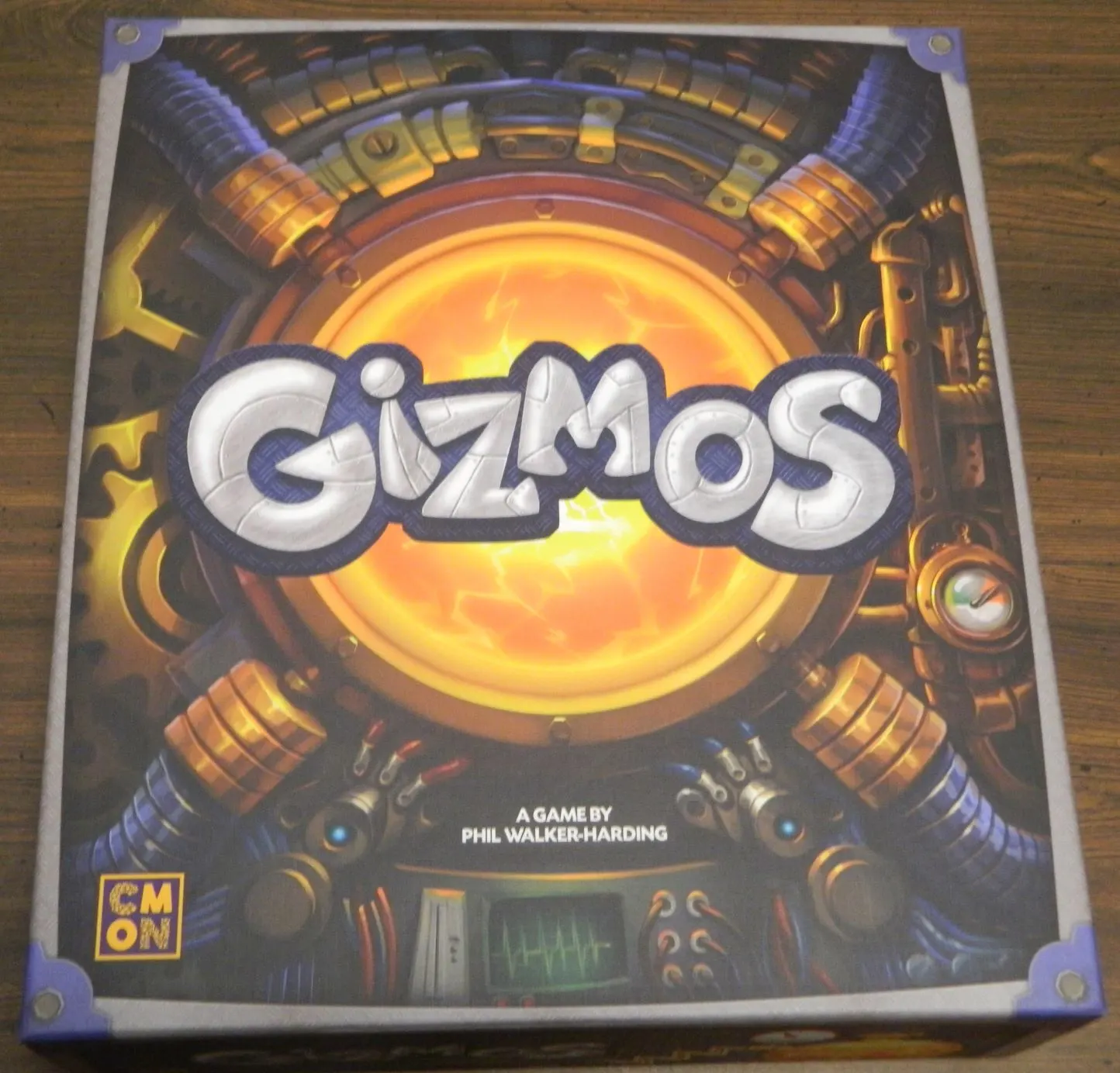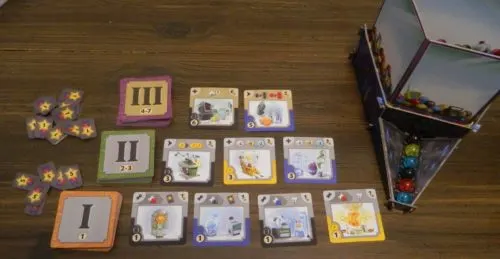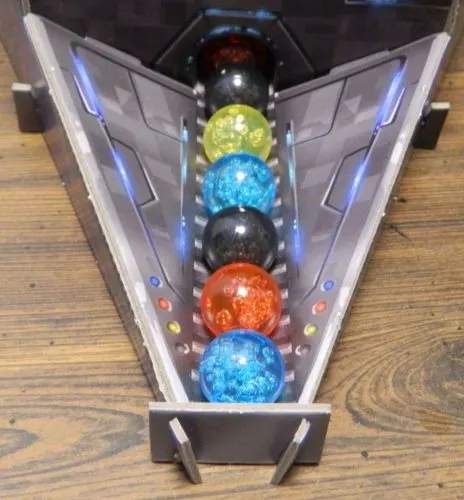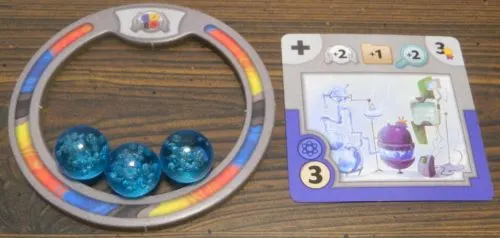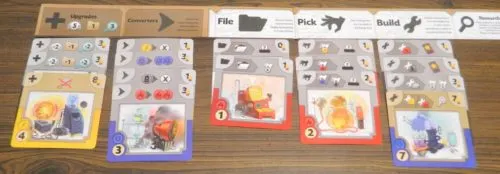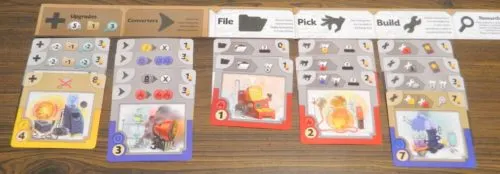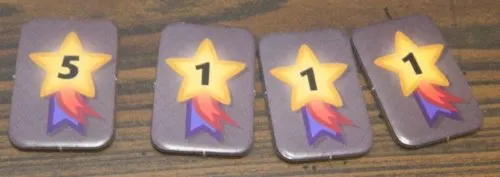While Phil Walker-Harding may not be the most well known board game designer, in the last decade he has ended up creating quite a few really good board games. In particular I am a big fan of the card game Sushi Go! which he designed back in 2013. Today I am looking at another of Phil Walker-Harding’s games Gizmos. I have to admit that I didn’t know a lot about the game heading into it but I was intrigued. In addition to being designed by a designer I like it also has a card drafting/engine building mechanic which is a genre that I am really enjoying recently. The game is also well liked as it currently stands around the 300th best board game of all time on Board Game Geek. All of this along with the scientist making weird gizmos theme made me really interested in trying out Gizmos. Gizmos is a surprisingly simple and yet deep board game that the whole family can enjoy.
How to Play Gizmos
Setup
- Take a number of player dashboards equal to the number of players. One of the dashboards that you take must be the first player dashboard which is a different color than the other dashboards. Shuffle up the dashboards and each player will randomly draw one. The player that draws the first player dashboard will be the first player.
- Each player takes an energy storage ring and a starting gizmo card. The ring is placed in front of the player. The starting gizmo card is placed underneath the file symbol on the player’s dashboard.

- Divide the cards by their levels (shown on the back of the cards) and shuffle each deck separately. Randomly remove 20 cards from the level three deck and return them to the box.
- Place all three level decks in the middle of the table. You will turn over four cards from level one, three cards from level two, and two cards from level three. These cards are placed next to their corresponding draw pile.
- Place the victory point tokens in the middle of the table.
- Assemble the Energy Dispenser and place all of the marbles inside.
Playing the Game
On a player’s turn they will be able to take one of four actions:
- File
- Pick
- Build
- Research
After a player has taken one of these actions play will pass to the next player clockwise.
File
If a player has chosen the file action they will look through the face up cards on the table and choose one they would like to keep. They can take a card from any level. The card they choose will be placed to the right side of their dashboard in an area referred to as the archive. A card from the corresponding deck will be flipped over to replace the card that was taken.

This player has archived the blue card. On a future turn they can build the gizmo and add it to their display.
There is a limit on how many cards you can have in your archive at any time. The limit is indicated by the file symbol in the upgrades section of your dashboard. At the beginning of the game you may only have one card in the archive at a time. You may acquire cards during the game that upgrades this limit allowing you to store more cards. If you are currently at your archive limit you cannot take the file action on your turn.
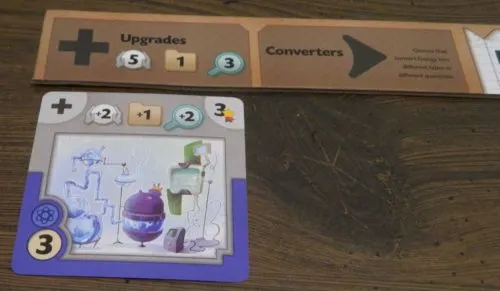
To begin the game this player will be able to hold five energy, archive one card, and research three cards. By adding the gizmo card this player can hold seven energy, archive two cards, and research five cards.
Pick
When you choose the pick action you can choose one of the six marbles that are displayed in the energy row. The marble you choose will be added to your energy storage ring.
There is a limit on how much energy you can store at any given time which is shown by the number inside the circle on the upgrade section of your dashboard. At the beginning of the game you may only hold five energy at a time. If you reach your energy limit you cannot acquire more energy until you use some of it.
Various abilities on the cards will feature a circle with a question mark in the center. This symbol indicates that you will draw a random energy from the top of the dispenser. This is not considered a pick action.
Build
When you have acquired enough energy you can use your turn to build a gizmo. When you activate this ability you will be able to build one gizmo card and add it to the corresponding space below your dashboard. To build a gizmo you must pay energy equal to the type and number shown in the bottom left corner. When choosing which gizmo to build you can either build one of the gizmos from your archive or you can build one of the gizmos still available in the center of the table. If you take one of the gizmos from the center of the table you will replace it with another card from the same level. To build the gizmo you will pay the corresponding amount of energy from your energy storage ring to the energy dispenser.
After you have built a gizmo you will place it under the section of your dashboard that matches the symbol in the top left corner of the card. When you acquire more than one card of the same type you will stack them so you can see the top line of each card so you can see the information regarding their effect.
When building you need to keep track of the converters that you have available to you. At the beginning of the game you won’t have any converters. As you build gizmos though they may give you converter abilities. Each converter ability can only be used once per turn. For an example of each type of converter see the Abilities section.
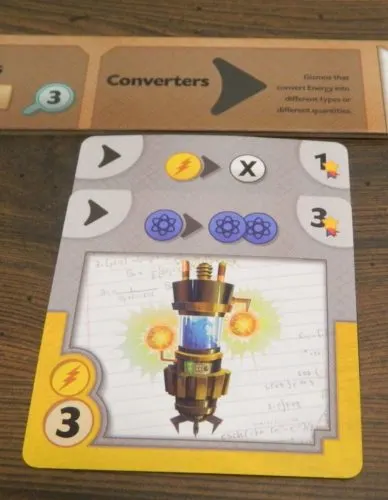
This is the converters section of the player’s display. The top card allows the player to turn a yellow energy into any other color. The bottom card allows the player to turn one blue energy into two blue energy.
Research
When you choose the research option you will choose one of the three levels of cards. You will then take cards from the corresponding deck. The number of cards that you will be able to take depends on your research ability. At the beginning of the game your research ability is three (the number inside the magnifying glass) which will allow you to draw the top three cards. You can acquire gizmo cards that increase this number.
You will look through the cards that you drew and choose one that you would like to keep. You can also choose not to take any of the cards. The cards that are not chosen are put on the bottom of their corresponding deck. You can choose the order that you want to place them at the bottom of the deck. Then with the card you chose you can either build it or file it. You will then take the corresponding file or build action.
Triggering Card Effects
The key to doing well in Gizmos is taking advantage of the effects on your cards. When you perform actions in the game you may have the ability to activate the abilities of the gizmo cards that you had previously built. Therefore whenever you perform an action you need to look under the corresponding section of your dashboard to see if it triggered any of your card’s effects. When a card’s effect is triggered you can take advantage of its ability at any time during your current turn. You may only use the ability on each card once each turn though even if it is triggered multiple times. A card’s ability can be activated on the turn that it is played but only if it is activated by something other than the card itself being played.
Along the top of each card there will be symbols in the middle of the card. The left side of this area will indicate the conditions that will trigger the effect. Whenever these conditions are met the player can activate the card’s ability. On the right side it will show what ability the player can take if the effect is triggered.
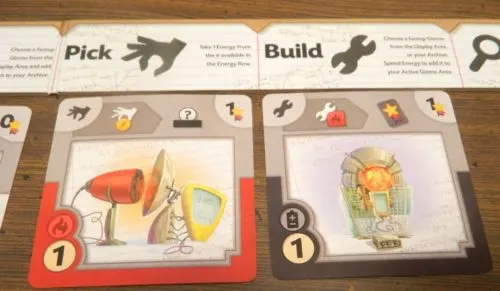
This player has just built the red card. The black card on the right has a special ability that is triggered each time a red gizmo is built. As a red gizmo was built this player will get to take a victory point token.
Triggers

Based on the file symbol on the left side whenever a player takes the file action they will get to take the action on the right.
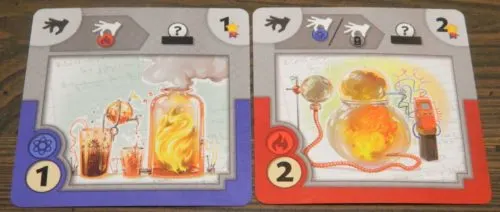
These two cards show two of the pick triggers in the game. The card on the left will be activated whenever the player picks a red energy from the display. The card on the right will be activated whenever the player picks a blue or a black energy from the display.
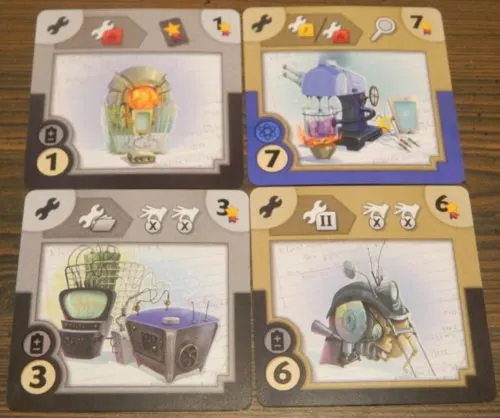
Here are the four different types of build triggers. The card in the upper left will be triggered when the player builds a red gizmo. The card in the top right will be triggered when the player builds a yellow or red gizmo. The bottom left card will be triggered when the player builds a gizmo from their archive. The bottom right card will be triggered when the player builds a level two gizmo.
Abilities
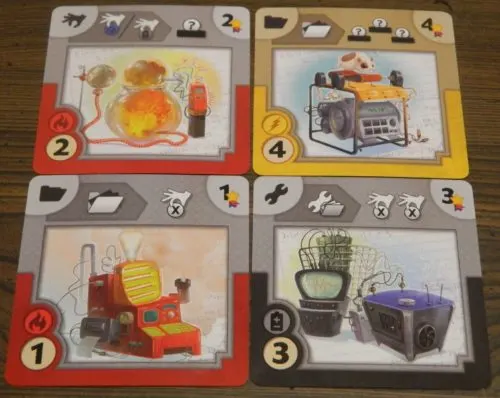
When the card in the top left corner is activated the player will get to randomly take a marble from the top of the dispenser. When the card in the top right is activated the player will get to randomly draw three marbles. The card in the bottom left will allow the player to pick a marble of any color from the display. The card in the bottom right will allow the player to pick two marbles of any color from the display.
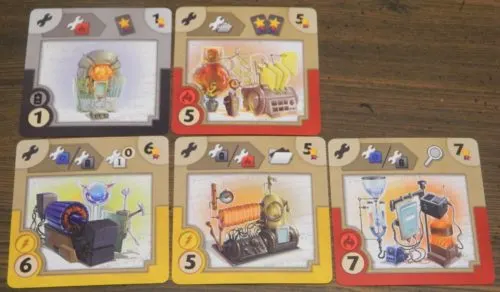
The card in the top left will give the player one victory point token when it is activated. The card in the top right will give the player two victory points tokens when it is activated. The card in the bottom left corner will allow the player to build a level one gizmo without having to pay any energy. The card in the bottom middle allows the player to take the file action. The card in the bottom right lets the player take the research action.
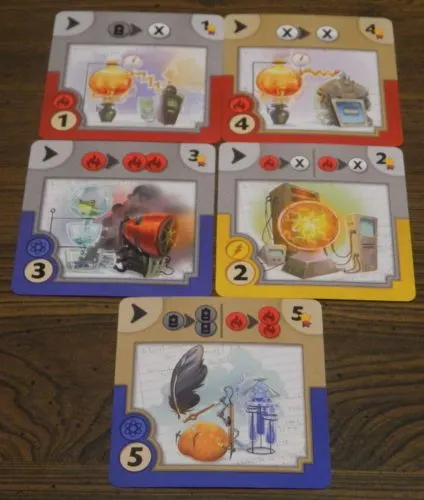
These converters have the following abilities. The left card in the top row can turn a black energy into any other type of energy. The card in the top right corner can turn any one energy into any other type of energy. The middle left card allows the player to turn one red energy into two red energy. The middle right card allows a player to turn two different red energies into any other type of energy. The bottom card allows the player to either turn one black energy into two black energy or one red energy into two red energy.
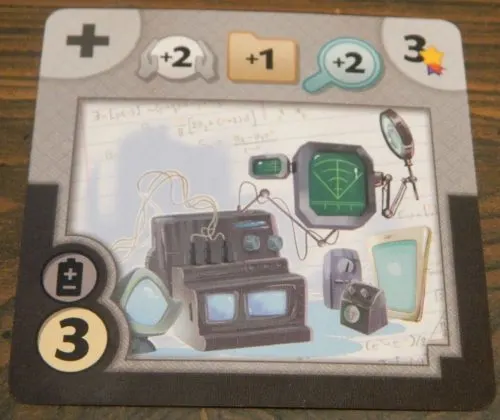
This upgrade card will increase the amount of energy the player can store by two. The player can also archive one more gizmo card. When researching the player can look at two more cards.
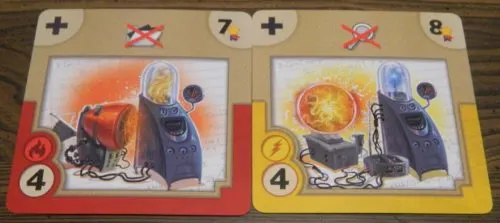
After a player acquires one of these cards they will no longer be able to take the corresponding action for the rest of the game. The card on the left prevents the player from taking the file action. The card on the right prevents a player from taking the research action.

These three cards let you spend one less energy when you build under certain circumstances. The card on the left lets you spend one less energy when building a level two gizmo. The card in the middle lets you spend one less energy when you are building from the archives. The card on the right lets you spend one less energy when you immediately build the gizmo you take from a research action.
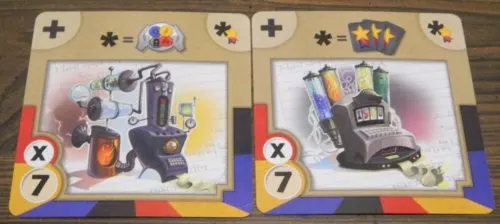
These two cards will score points for the player at the end of the game. The card on the left will score points equal to the number of energy marbles that the player has at the end of the game. The card on the right will be worth as many points as victory point tokens that the player acquired during the game.
End of Game
Gizmos can end in one of two ways:
- A player builds their fourth level three gizmo.
- A player builds their 16th gizmo card (this includes the starting card).
When one of these two events occur the game will end once all of the players have had the same number of turns.
Players will tally up the victory point tokens they acquired during the game and add them to the victory points on the gizmos they built (top right corner). The player who earned the most victory points wins the game. If there is a tie the player who built the most gizmos will win. If there is still a tie the player with the most energy in their storage area will win. If there is still a tie the player furthest from the first player, going in a clockwise direction, will break the tie.
- This player has scored 39 points from the gizmos that they built throughout the game.
- This player has acquired eight victory point tokens in the board game Gizmos.
My Thoughts on Gizmos
Heading into playing Gizmos I didn’t know exactly what to expect. With the game having an age recommendation of 14+ I was expecting the game to be somewhat complicated. It really isn’t though. Basically the game consists of four different actions that you can choose between. You can take a face up card and set it aside for later, take an energy marble which will be used to build cards, you can use your marbles to build cards, or you can research in order to give yourself more card options. While you have to choose between these four options all four are quite straightforward. I don’t think you would have any trouble teaching the game to new players within five to ten minutes. With how simple the mechanics are I honestly don’t know why the game has a recommended age of 14+ as kids a few years younger than that shouldn’t have any trouble understanding how to play the game.
With just four basic actions to choose from you might think that Gizmos is a pretty basic game. That is far from the truth though. While there are only four actions in the game, the real game comes from activating card abilities. At the beginning of the game you will mostly be deciding between which of the four actions that you want to take. You may be able to activate one or two card abilities but that is about it. As you progress through the game though the chain reactions become a key aspect of the Gizmos. You reach a point where the first action you take on your turn may be more about the abilities that you will trigger than the actual action you chose to take. For example towards the end of a game there may be no reason to actually choose the pick option as you could easily trigger enough pick actions by choosing other actions at the beginning of your turn.
This is the case because the real goal of Gizmos is to build an engine that you can use each turn to maximize the number of actions that you can take. At the beginning of the game you likely will only be able to take one or two actions. By the end of the game you could easily take five or more actions each turn. When choosing what cards you want to build you need to consider how they will interact with other cards that you have already built. To illustrate lets say that on a previous turn you built a card that activates when you build a yellow card. On a future turn when you build a yellow gizmo you will then activate this card. That card might allow you to pick a marble from the supply. You might then have another card that can be activated if you pick a certain color marble. If you pick that color you can then take another action. Thus by choosing the build action you are able to build a card, pick a marble and take another action. You ended up turning one action into three actions. This is a very simple chain reaction as you can build chains significantly longer. If you can build a good engine it will open up the number of potential actions that you can take on a turn giving you more options to implement your strategy.
While this might not appeal to everyone I love this type of gameplay. There is just something really satisfying about being able to build a well oiled machine. You begin each game only being able to take one action each turn and by the end of the game you can easily be taking five or more actions each turn. It is just really enjoyable trying to find a way to mix and match cards in order to set off the longest chain reaction possible. Creating a strong engine is key to winning the game. If you aren’t able to create an engine where the cards feed off one another you are going to greatly limit how many actions you are going to be able to take compared to the other player(s). If this doesn’t sound that interesting to you Gizmos won’t be for you. People who find the puzzle of creating an interconnected web of cards interesting though should have a blast with Gizmos.
I have always enjoyed this type of gameplay but it had the potential to be a disaster as a bunch of cards could be triggered at a time. This is not nearly as bad as it could have been though because Gizmos was brilliant in how it chose to handle all of the cards’ abilities. All of the card abilities are broken down into categories. The categories correspond to the basic actions you can take along with a couple passive abilities. Cards that are activated by actions are placed under the corresponding section of the dashboard. Therefore after a player takes an action they can look below the corresponding action on their dashboard to see if they activated any abilities. By sorting the cards in this way you can quickly search through the cards that were potentially activated instead of having to look at all of your cards. This makes it much easier to deal with all of the cards that are triggered streamlining a process that could have been a pain.
Due to the chain reactions there is quite a bit of strategy to Gizmos. Creating a strong engine is key to doing well in the game. Gizmos gives you a lot of flexibility in how you chose to build your engine though. You can only score points from the gizmos you build as well as receiving some scoring tokens from the abilities on some of the cards. There are quite a few different ways of approaching the game though giving you plenty of opportunities to craft your own strategy. Some players may strive to build a lot of gizmos quickly that provide points themselves or give you the opportunity to receive victory point tokens. Others may take a more long term strategy where they build a lot of cards that generate energy. You can then use all of that energy to buy more expensive cards that are worth a lot of points. The cards you decide to build will have an impact on what actions you are going to favor throughout the game as you want to take advantage of your card abilities as much as possible. When you mix all of these elements together there a lot of strategic possibilities where the game should remain interesting for quite a while.
On top of the gameplay I thought Gizmos’ components were also quite good. The standout component is clearly the dispenser. The dispenser is only made of cardboard and has a few issues with marbles falling out and it being possible to see the next marble that will be revealed before it is revealed. Otherwise the component is quite cool. It adds a lot to the theme and even serves a gameplay purpose as it randomly selects the marbles for the supply and prepares the next marble when one is taken. The other components are also quite nice. I really liked the game’s artwork as it looks nice and makes it really easy to find the information you need. The game also includes plenty of cards where every game will feel unique as there are plenty of gizmos that you can build. The components aren’t good enough to be a selling point themselves, but they do a good job supporting the gameplay.
Regular readers of Geeky Hobbies will probably be having a sense of deja vu at this point as Gizmos probably sounds a lot like Wingspan which I reviewed recently. While the two game’s themes couldn’t be much different, the two games actually share quite a bit in common. In both games you are acquiring cards that you try to use to set up chain reactions to be able to take advantage of more actions. The games share a lot in common but are not exactly the same. Gizmos seems to let you set up larger chain reactions and is probably the simpler game overall. I would probably say that Wingspan is slightly better though as there are more strategic options in the game. I would probably say that Gizmos is more accessible though and would probably work better as a family game. Both are great games though that I had a lot of fun with and I would highly recommend both games.
There are a lot of things that I really liked about Gizmos. There are a few issues that keep the game from being perfect though.
Just with Wingspan Gizmos also suffers from having little player interaction. In most board games the players are competing against one another and thus one player’s actions will impact the other players. In some games you can have a lot of impact on the other players as you can ruin their chances of winning the game. This is not really the case in Gizmos as players can’t have much impact on one another. Basically the only player interaction in the game involves taking energy from the supply or cards before another player is able to take them. This can mess with a player’s strategy if they really needed that card or energy, but otherwise you don’t have a lot of impact over how well the other players do. For the most part you are playing your own game with players comparing their scores at the end of the game. For this reason there isn’t a huge difference to the gameplay whether you play with two or four players. Players who like a lot of player interaction in their games will probably be disappointed with this aspect of the game.
There is also some reliance on luck in the game. I wouldn’t say that luck plays a huge role in the game, but it will have some impact on who ultimately wins the game. A superior strategy will likely overcome some bad luck, but luck can be the deciding factor when two or more players have similar strategies. Most of the luck comes from two areas. First there is luck in what energy marbles are available to you. There is always the opportunity to randomly draw the energy you need, but it is much easier to have the energy you need available where you can pick it so you are guaranteed to get what you need. There is also some card draw luck. If the face up cards match your current strategy it makes it easier to implement it. You can always research to get more options, but there is risk that you won’t draw any cards that you want. If the type of cards that you want aren’t available on the table or you can’t draw them in research you will be forced to change up your strategy.
The final “issue” that I had with Gizmos is something that I honestly didn’t expect. I am the type of person that loves building a strong engine that triggers a bunch of positive effects. I can’t believe that I am saying this but I think Gizmos might take this a little too far. At the beginning of the game the chain reactions can be pretty small. An action may trigger one or two other actions. In your last couple of rounds though this can get quite a bit more complicated. You could easily have one action trigger another action which then triggers another action. This could lead to you taking advantage of five or more card abilities in one turn. This gives you a lot of flexibility as it allows you to do a lot on a turn. Sometimes you trigger so many abilities though that you don’t even use all of them. In particular you might pass on randomly drawing energy as it could fill your supply with energy that you don’t have a use for. It is sometimes hard to keep track of everything that you have triggered. I kind of wish the game would have included some sort of tokens that you could use to indicate which abilities you have triggered and which you have already used. It is usually not that hard to keep track, but if you don’t pay attention you could miss one of the abilities that you could have used.
Should You Buy Gizmos?
Gizmos might not quite be a perfect game but it is a very good game. With a recommended age of 14+ I have to say that Gizmos is a lot easier to play that you would expect. This is because when you get down to the basics the mechanics are pretty simple and self explanatory. The mechanics may be simple but there is quite a bit hiding underneath the surface. This is because there is a lot more to Gizmos than just the four basic actions. The heart of Gizmos is the ability to create a chain reaction between the cards you build throughout the game. The first action you take on your turn can activate some of your card abilities which can then activate other abilities. The key to doing well in Gizmos is to create an engine where you can turn one action into several actions. It is a really satisfying experience being able to build a long chain reaction that allows you to take a lot of actions on your turn. Between the actions and being able to create chain reactions there is a lot of strategy in Gizmos as you try to find the right set of cards to maximize your points. Like a lot of games in this genre though Gizmos doesn’t have a lot of player interaction. It also relies on a little too much luck at times and it is sometimes hard to keep track of all of the abilities you trigger on later turns.
If you have never been a huge fan of engine building games where you are trying to create combinations of cards that feed off one another, Gizmos probably won’t be for you. People who are at all interested in Gizmos’ concept though should have a lot of fun with the game and should seriously consider picking it up.

